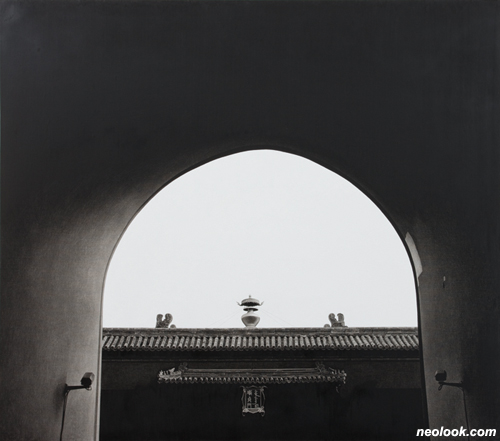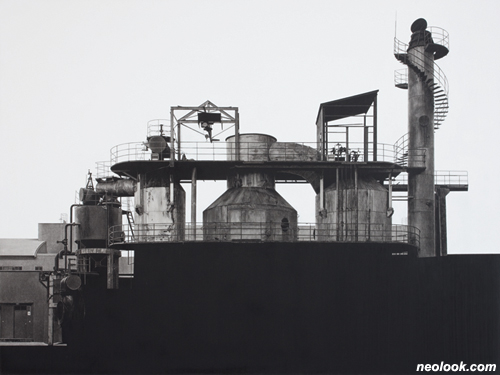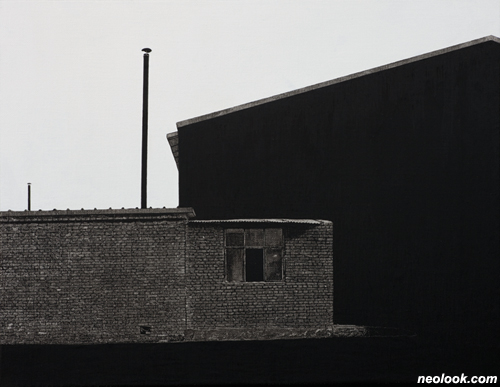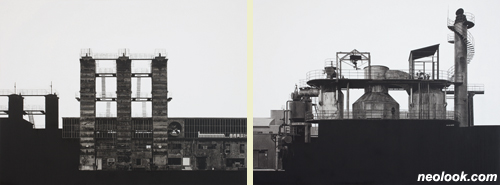- ● homepage
- ● archives
- ● restoration
- ● books
- ● big banners
- ● post board
- ■ neo's search
- ■ about us
- ■ 게재방법 안내
- 개인정보처리방침

- [email protected]
- Tel. 02_335_7922
- Fax. 02_335_7929
- 10:00am~04:30pm
- 월요일~금요일
- 3/3(월) 대체공휴일

검은색조의 방식: Gray징(京)
신선주展 / SHINSUNJOO / 辛善珠 / painting 2011_1013 ▶ 2011_1106 / 월요일 휴관
● 위 이미지를 클릭하면 네오룩 아카이브 Vol.20090905e | 신선주展으로 갑니다.
작가와의 대화 / 2011_1014_금요일_05:00pm
오프닝 리셉션 / 2011_1014_금요일_06:00pm
관람시간 / 10:00am~06:00pm / 월요일 휴관
갤러리 현대_16번지 GALLERY HYUNDAI 16 BUNGEE 서울 종로구 사간동 16번지 Tel. +82.2.722.3503 www.16bungee.com
시각을 가능하게 하는 암흑지점들 ● 여러 나라 말이 조합된 전시부제 'Manière-noir: Gray징(京)'은 회화와 사진의 경계 위에서 여러 차원을 담으려는 작가의 의지가 느껴진다. 전시된 작품들은 부제 그대로 회색 톤의 베이징이다. 흰색/회색/검정색의 세 가지 톤으로 조율된 베이징 풍경은 자금성이나 고택같이 오래된 시간의 층들이 보존된 장소부터 공장이나 공장을 개조한 현대식 스튜디오처럼 기계적 즉물성이 두드러진 장소에 이른다. 어느 곳이건 단순하고 강렬한 느낌을 준다. 그것은 작가가 발견한 장소의 특수성도 있지만, 벨벳 같은 느낌을 주는 진한 블랙의 추상적인 색 면과 분석적으로 포착된 피사체의 각도에 힘입은 바 크다. 오일 파스텔로 칠해진 면을 니들로 긁어서 만든 섬세한 톤은 강한 구도와 색 면을 보충한다. 이번 전시는 2009년 열렸던 'Manière-noir: Beijing Photos' 전과 작품 자료를 공유하지만, 드로잉과 회화적 과정에 더 방점이 찍혀있다. 신선주는 국내외에서 회화와 사진을 모두 전공했다. 그러나 회화를 먼저 시작한 그녀에게 손끝 하나하나를 통해 만들어지는 회화는 도구나 매체의 역할을 할 뿐인 사진에 비해 더 애착이 간다.

- 신선주_The Ullens Center for Contemporary Art (UCCA)_캔버스에 오일파스텔, 새김_140×150cm_2010
장소성이 어느 정도 유지된 상태에서, 블랙과 화이트를 대조하는 회화적 게임은 작가에게 언제 끝날지 모르는 흥미진진한 과정이다. 인적이 없는 풍경들은 고요하고 적막하다. 흰색과 회색, 검정의 색 면으로 치환된 건물과 건물 사이에 흐르는 공기의 흐름만이 차분함 속에 잠재적 움직임을 부여할 뿐이다. 신선주의 작품은 장소성에 충실한 풍경으로부터 출발하지만, 기하학적 면 분할이 두드러진다. 장소를 찍을 때부터 구도는 세밀하게 조율된다. 서로 다른 톤의 두 건물이 맞물려 있는 작품 「2 chimneys」는 여러 가지 무채색이 적당한 비율로 배치된다. 작품 「MK2 art space」는 검정으로 무게 중심을 준 아랫부분, 흰 면으로 표시된 빛의 영역, 회색 하늘, 여러 회색 톤의 건물 배치가 기하학적이고 추상적이다. 화면의 추상적 균형을 위해 실제 장소는 변형되기도 한다. 공장처럼 군더더기 없는 기능적 장소가 정면으로 포착된 작품 「hmmmmmm...상상재설계」의 오른쪽 날개부분은 사진을 뒤집어 다른 장면의 어깨에 붙인 것이다. 고전적인 정면성에 충실한 신선주의 작품은 문처럼 대칭적인 구도를 가진 장면들이 많이 등장한다.

- 신선주_順貞門_캔버스에 오일파스텔, 새김_150×170cm_2011

- 신선주_hmmmmmm... 상상재설계_캔버스에 오일파스텔, 새김_150×200cm_2011
정면성이나 대칭성은 화면의 블랙과 함께 관객을 깊이 몰입시킨다. 작품 「順貞門」은 아치형 안에 건축물을 보여주는데, 건축적 구조가 하얀 하늘 부분을 감싸 안는다. 작품 「Old house in Beijing university」는 블랙으로 감싸인 문 안에 또 다른 문이 있다. 장소의 폐쇄성은 문을 에두른 블랙에 의해 강화된다. 출품되지는 않았지만 작품 「gap」이나 「HeiQiao-studio」처럼, 원근법적 구도를 가지는 경우에도, 화면은 육중한 자물쇠로 감겨있다는 느낌이다. 하늘은 블랙과 회색 톤의 인공적 구조물 사이에 놓인 하나의 틈일 뿐이다. 그러나 빛과 어둠 사이의 대화를 통해 작품을 진전시키는 과정 속에서, 닫힘은 열림을 위한 전제조건일 뿐이다. 신선주의 작품에서 두드러진 명암 대조는 풍경이라는 소재와 어우러져 빛과 어둠 사이에 펼쳐진 드라마를 낳는다. 인간의 상징적 우주에서 빛은 명백함을, 어둠은 혼돈의 영역을 차지한다. 그래서 빛은 진리나 계몽의 은유로 간주되었지만, 신선주의 작품에서 빛은 어둠을 강조하는 배경에 머문다. 사진이 빛을 인화지에 고정시킨 것이라면, 회화는 손으로 꼭꼭 눌러서 칠해지거나 긁어낸 무채색의 면이다. 투명한 형식이라기보다 불투명한 질료의 영역에 가까운 블랙은 끝없는 동굴이나 바닥모를 심연 같다. ● 이 영역은 블랙홀처럼 시선을 급속하게 빨아들이지만, 시선은 머무를 곳을 찾지 못한 채 방황한다. 여기에는 기계적 시점(=사진)의 순간성과 시간성을 담지 하는 육안의 운동이 공존한다. 블랙 영역에서 눈을 감는 것과 뜨는 것의 차이가 없다. 현전에 충실한 시각적 인식의 모델은 근저로부터 무너진다. 이 보이지 않는 영역은 플라톤이 말한 코라와 닮았다. 플라톤은 「티마에우스」에서 '볼 수도 없고 형식도 없는 어떤 것이면서도 모든 것을 담고서 영원한 본질들을 생성의 유희로 끌어들이는 그 그릇(=코라)을 어떻게 볼 것인가'를 묻는다. 그에 대한 대답은 '그 대상들에 관한 우리의 시각은 우리가 보지 않는 것, 그리고 정확히 무엇을 볼 수 없는 것에 대한 시각으로 남아있다'는 것이다. 즉 우리의 시각의 맹목이다. 혹은 맹점(盲點)이다. 존 맥컴버는 이러한 주제를 다룬 논문 「데리다의 시각폐쇄」에서 맹점 주변에 조직된 시각은 볼 수는 없지만, 우리 시계의 형태와 범위에 영향을 미친다고 말한다. 우리가 볼 수 없는 어떤 것을 보여주는 신선주의 작품은 맹점 주변에 조직된 시각인 셈이다. 그것은 '진리의 은유로서의 빛' (한스 블루멘베르크)이라는 '형이상학을 낳는 시각의 폭력을 파열하는'(데리다) 또 다른 시각이다.

- 신선주_Old House in Beijing University_캔버스에 오일파스텔, 새김_100×120cm_2010
존 맥컴버에 의하면 플라톤이 말하는 맹점은 우리가 볼 수 없는 태양이다. 그리고 바로 이 사실로 인해 맹점은 형식 자체의 영역, 존재를 넘어선 그 어떤 것을 근원으로 하는 충만함을 구조화하는 것이다. 신선주의 작품에서 시각의 대상은 더 이상 현전이 아니다. 그것은 형식이라기보다는 '흔적'(데리다)이다. 자신의 맹점 주위에 조직되는 시각이란 흔적 그 자체를 향해 열린 시각이다. 안료의 진한 밀도로 뒤덮인 블랙은 역설적으로 공이나 허의 공간처럼 보인다. 맹점과 맹목으로부터 시각이 가능하듯이, 이 공과 허의 공간으로부터 실재가 가능해진다. 이 암흑의 지점(들)은 작품 속 현실 그 자체를 구조화하고, 실재적인 것에 내적 일관성을 부여하는 허구이다. 이 허구가 사라지면 나머지 현실도 힘을 잃는다. 그것은 미란 보조비치가 말한 '암흑지점'과 같다. 그는 「암흑지점」에서 근대 초기 제러미 벤섬이 고안한 원형 감옥, 즉 완전히 투명하며 빛으로 가득한 판옵티콘 우주 속에서 비가시성의 실체를 논한다. 그에 의하면 모든 죄수를 응시할 수 있는 암흑 지점이라는 하나의 허구(상상, 비존재)가 일망 감시체제를 작동시킨다. 조망적 시점이 많은 신선주의 작품--가령, 대칭적 풍경 중심이 블랙으로 채워져 있는(또는 뚫려있는) 「불향각」(2009)같은 이전 작품의 예--에서 이 모델은 발견된다.

- 신선주_Two Chimneys_캔버스에 오일파스텔, 새김_31.8×40.9cm_2011
판옵티콘은 근대사회의 정치경제학적 구조와 연결되지만, 동시에 결여를 통해 작동하는 힘(권력)의 기제를 알려준다는 점에서, 시각 예술에서도 의미 있는 모델이 된다. 감시하는 자의 응시는 가시적인 것의 한계를 넘어 비가시적인 것으로까지 확장된다. 감시자가 검은 실루엣으로만 드러나는 감시등실은 모든 것을 보는 응시의 재생을 위한 도구이다. 신선주의 작품 속 블랙은 투명한 거울이 아닌, 불투명한 그림자의 모델에 가깝다. 르네상스 이래로 주도적이었던 거울의 모델은 중심으로부터 뻗어 나오며 유기적인 질서로 조직되는 재현적 공간을 낳았다. 이에 부합되지 않는 무질서는 결여와 부재로만 정의된다. 그러나 신선주의 작품에서 짙은 그림자처럼 드리워진 블랙은 이 무질서의 영역을 활성화한다. 빅토르 스토이치타는 「그림자의 짧은 역사」에서 최초의 유사물이 만들어진 것은 그림자로부터였다는 사실, 즉 예술적 재현의 탄생이 음화(陰畵)에 있다는 것을 밝힌다. 그는 고대 플리니우스의 「박물지」에서 회화가 선으로 윤곽을 그린 인간의 그림자에서 최초로 태어났다고 말한다. 회화가 처음 나타났을 때 그것은 신체의 부재와 그 투영된 형상의 존재가 포함되어 있었다. ● 이 경우 실물에 대한 그림자의 유사성은 결정적이다. 사진 역시 대상과의 물리적 연관성을 가지는 지표(index)로 간주된다. 신선주의 작품에서 블랙은 도상적 유사물인 지표를 잠식한다. 그것은 말레비치의 「검은 사각형」처럼, 반(反)재현적 본성을 보여준다. 빅토르 스토이치타는 말레비치의 검은 사각형이 무대의 커튼으로 처음 착상되었다고 밝힌다. 커튼은 재현이 아니라 가리는 것이고 혹은 걸어놓음으로서 재현을 가능하게 하는 것이다. 신선주의 작품 속 블랙 역시 사각형을 채운 블랙처럼 재현을 가능하게 하는 의미의 체계들을 불확실한 것으로 만든다. 또는 원근법과 통합된 그림자 투사로서 '그림자로 그리기'(스토이치타) 라는 방식이다. 현대에 와서 미메시스의 대표자가 된 사진은 그 정점에서 미메시스의 힘을 무장해제 시켜버린다. 신선주의 작품에서 고전적 균형을 이룬 신비한 고요 속 블랙은 '광학적 공간을 만드는 손가락이 아니라, 촉각적 공간을 만드는 손'(들뢰즈)을 복구하는 장이다. 그것은 기력이 쇠해진 회화에 잠재태들이 우글거리는 야생적 바탕을 복원시킨다. ■ 이선영

- 신선주_MK2 Art Space_캔버스에 오일파스텔, 새김_150×150cm_2010
Shin, Sun Joo - The Dark Spot that enables vision ● The subtitle of the exhibition, 'Manière-noir: Gray Zing(京)', in itself shows the combination of different languages. This portrays the will of the artist who wishes to convey various layers/realms of art on the verge of painting and photography. The works for this exhibition show Beijing in grey tone as the subtitle suggests. The carefully toned down landscape of Beijing in grey, white and black tones reveals historic and old buildings such as the Forbidden City, and old residences which carefully retain the multiple layers of time to what was once a factory, but is now modern art studios which protrude mechanical Sachlichkeit. ● All of these chosen places emanate a simple yet strong impression. This is mainly because of the site-specific features of those places, but also because of the abstract features of dark black (somewhat feeling like velvet) and a carefully captured angle after an analytic scrutiny of the site. The general tone of the art was carefully directed, created by needle scraping on an oil-pastern drawn area. This produces a supplementary effect on the strongly protruded composition and color field. ● This exhibition shares works that were previously shown in the 'Manière-noir: Beijing Photos' exhibition in 2009, but this year's exhibition is more inclined to the drawings and painterly procedures of the art. Shin Sun-Joo studied both painting and photography, yet Shin subtly expresses her affection toward painting which requires meticulous and careful touches, rather than photography which simply plays the role of medium or tools in her works. ● While still maintaining site-specificity, we can see the painterly game which contrasts black and white with a tint of psychological tension. Those landscapes are barren, quiet and serene. The buildings have been substituted by a white, grey and black color field, yet we can still trace the flow of air in between buildings, endowing latent movement in this midst of stillness. ● Shin's works depart from a landscape which is very vernacular in terms of site-specificity; however, it is noticeable how she geometrically divides the fields. Shin carefully orchestrates the composition even when photographing the site itself. Her work 「Two chimneys」(2011) shows two interlocked buildings in different tones, and achromatic colors. It is appropriately displayed in 「MK2 Art Space」(2010). It shows somewhat abstract and geometric features of the composition. The lower part shows black, added with the shades of light (in white tone), grey sky, and various other grey-tone buildings. The actual place/site undergoes modifications for the sake of the abstract balances of the scene. The 「hmmmmmm...Imaginary Reconstruction」(2011) captures the front of the highly functional site (without any superflousness), like some factory; and Shin placed a reverse side of the other scene as well. Shin is loyal to the front-façade-ness of classical arts and frequently shows contrasting composition, for example, with doors. ● Those frontal and contrasting features along with black/grayish tones allow audiences to be deeply immersed into the works. 「Sunjeongmun's順貞門」(2011) work presents a building placed within an arch, and its architecture structure embraces a white sky section. 「Old house in Beijing University」(2010) shows a door inside a black-door. The closedness of the site is further protruded by the black color that emphasizes the frames of the door. Her work, 「Gap」(2010) or 「HeiQiao Studio no.1」(2009) illustrate a screen, seemingly locked by the heavy lock despite an adherence to the perspective methodology. ● The sky itself is a crack laid in between artificial structures in grey-black tones. However, in the process of unfolding dialogues between the light and darkness, the closedness is only a precondition to the openness. The projected contrasts of light and shade shown in Shin's works are being merged into the subject, landscape, while telling the drama of light and dark. In a civilized world, light is generally regarded as obviousness or indisputability, and darkness is often regarded as chaos. This is why light is often understood as the metaphor of truth or enlightenment; however, light remains in the realm of background which emphasizes darkness. While the photography captures and fixates light on the photographic paper, painting is the achromatic color plane field, painted or raked by meticulous hands. The black color seems like a bottomless cave or abyss with its opaque matière rather than being a transparent feature. ● This is the realm of the so-called black hole, rapidly absorbing our gaze, yet our gazes soon wander on the screen without finding an anchoring spot. This is because of the concurrence of instantaneity of mechanical time and zeitlichkeit (temporality) produced by movement of physical eyes. There's no difference in closing or opening eyes in this dark realm. Such a model of visual perception, still loyal to the Zustandlichkeit (presence), collapses in the nearest place. This unseen realm resembles the Platon's Khôra concept. Platon asks in Timaeus how we could see the holding place that draws perpetual substances, and still invite the game of creation, while still lacking forms and visibility. ● The answer for this question would be that our perspectives toward such objects lie in a realm that we do not see, and what we cannot see. In other words, in the realm of the blinded spot. John McCumber in his 「Derrida and the Closure of Vision」states that we would not be able to see the constructed vision around the blind spot, but it does influence the scope and forms of the visual field. Shin's works show something that we are not able to see, i.e. constructed vision near or on our blind spots. This is identified and explained by the words of Hans Blumenberg 'light as the metaphor of mighty truth' and Derrida's 'rupture of violence of time that give rise to metaphysics'. ● According to John McCumber, what Platon meant by blind spot is the sun that we could never directly face or see. And this is why and how the blind spot could structuralize the fullness of substance which goes beyond the realm of form itself, or its existence. In Shin's works, the object of vision is not the presence, it is 'trace' (Derrida) rather than some form. ● The vision structuralized around one's blind spot is the open vision toward the trace itself. The black, covered and filled with the thick and dense pigments, ironically seems like the space of emptiness. As it is possible to have vision emanated from the blind-spot, the real could be born from this space of emptiness and nothingness. Such spots of darkness structuralize the reality within the work itself, and yet, endow inner consistency toward something that is the real. ● When such fiction disappears, the remaining reality loses its potency. This is the same as the 'an utterly dark spot' mentioned by Miran Bozovic. In his 'An Utterly Dark Spot', Bozovic discusses the reality of the invisibility in the midst of a panopticon-like universe that is filled with entirely transparent light. Here, the panopticon is that of Jeremy Bentham. According to Bozovic, certain fiction (imaginary, non-existence) of such an utterly dark spot that could gaze at all prisoners, activates the panopticon. Shin's works illustrate that observatory gazes could be cited as models for this, especially her work 「Summer Palace」(2009) in which the contrasting landscape's center is filled with (or opened with) black color. ● The concept of Panopticon is related to the modern society's political and economic structure. At the same time, it could be a significant model for visual art since it connotes the impetus of power (authority) by showing what is lacking. The gaze of the surveillance is further expanded to include the non-visual realm, overcoming the limit of visibility. ● The monitoring lamp room reveals the watcher only in black silhouette as if illustrating the fact that it is the tool for representing the gaze toward the all. The blackness in Shin's works is more close to the model of opaque shadow, rather than transparent mirror. The mirror model which prevailed art since the Renaissance era, gave rise to a reproduction of space, in a way that the space is constructed/born from the center then spread to the peripheral in an organic order. Others that do not correspond to such order were defined as 'mal', absencent and lacking. ● However, in Shin's works, such dark shadow-like blackness vitalizes this realm of chaos and non-orderliness. Victor Stoichita in his 「A short history of the Shadow」argues that the first reproduction was produced from a shadow. In other words, the birth of artistic representation was from the negative. Plinius in his Naturalis Historia said that painting was first born when an artist drew the borderline of the human shadow in lines. When a painting was first born, it included the absence of body, as the projected form's existence. ● In this sense, the similarity and likeness between shadow and actual object is decisive. The photography is often regarded as an index that designates the physical relevance toward an object. In Shin's works, blackness encroaches the index, as an allegorical resemblance. As the black squares of Malevich, Shin's works show her instinct toward anti-representation. Victor Stoichita illustrates how Malevich's black square was first conceived by the stage curtain. The curtain veils something, instead of representing, yet it enables representation by hanging. ● The blackness in Shin's works renders the meaning structures as undutiful and obscure. Previously, those meaning structures enabled representation like some blackness within a black square. Or it could be described as a projected shadow converged with the conventional means of perspective, as of 'drawing with shadow (Stoichita)'. The medium of photography in the contemporary art became the vanguard of mimesis, yet, the photography dismantles the power of mimesis when it is in its peak. The blackness in Shin's works resonates mysterious serenity, achieving classical balance, as a platform that restores the hand that shapes manual space rather than a finger that shapes optical space (Deleuze). This in turn restores the wild habitat revived with the 'the Virtual', bestowing vitality to weakened painting. ■ Lee Sun-young
Vol.20111016a | 신선주展 / SHINSUNJOO / 辛善珠 / painting

